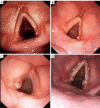Laryngeal contact granuloma after radiotherapy in patients with nasopharyngeal carcinoma: a case series
- PMID: 36819488
- PMCID: PMC9929759
- DOI: 10.21037/atm-22-5817
Laryngeal contact granuloma after radiotherapy in patients with nasopharyngeal carcinoma: a case series
Abstract
Background: Laryngeal contact granuloma (LCG) is a benign hypertrophic lesion and phonatory injury after abnormal vocal behavior is regarded as its major etiology. Patients receiving radiation for non-laryngeal head and neck tumors are troubled by persistent voice impairment. The occurrence of LCG after radiotherapy for nasopharyngeal carcinoma (NPC) in our practice has implored us to re-exam their underlying etiology. We hypothesize that a proportion of LCG results from voice change caused by non-laryngeal head and neck cancer radiotherapy and firstly describe a distinct LCG population originated after radiotherapy for NPC with respect to the clinical profile, presentation, prognosis and response to treatment of patients.
Methods: We retrospectively reviewed the laryngoscopic examination and tumor study findings to elucidate the common clinical features of patients who presented with LCG after radiotherapy for NPC. All patients were regularly monitored with telescopic examination until lesions disappeared. Data on age, sex, clinical presentation, telescopic findings, management, latency time of lesion formation, remission time and clinical outcome were reviewed.
Results: The medical review identified 27 cases of LCG secondary to radiotherapy for NPC. All lesions had been diagnosed during routine endoscopy following radiation. The interval between radiation onset and endoscopic diagnosis was 3.77 months (range, 0.67-11 months). 20 cases were resolved through simple observation, 4 cases were resolved with the administration of proton pump inhibitors (PPIs), and 3 cases with a poor response to PPI therapy required subsequent surgical resection. The mean remission time in the observation and PPI groups was 4.42 months (range, 0.73-18.9 months) and 5.78 months (range, 2.17-14.63 months), respectively. All patients recovered completely and none experienced recurrence during a mean follow-up of 32.44 months (range, 5.6-71.67 months).
Conclusions: Iatrogenic granulomas of vocal process are presenting after radiation for non-laryngeal head and neck cancers. In contrast with spontaneous granulomas, these granulomas can be cured at high remission rates and low recurrence trend without specific intervention. Thus, simple observation may be sufficient for radiation-induced LCG.
Keywords: Laryngeal contact granuloma (LCG); nasopharyngeal carcinoma (NPC); non-laryngeal head and neck cancer; radiotherapy (RT).
2023 Annals of Translational Medicine. All rights reserved.
Conflict of interest statement
Conflicts of Interest: All authors have completed the ICMJE uniform disclosure form (available at https://atm.amegroups.com/article/view/10.21037/atm-22-5817/coif). The authors have no conflicts of interest to declare.
Figures



Similar articles
-
Noninvasive Detection of Arytenoid Cartilage Calcification Using Computed Tomography and Prediction of Prognosis in Laryngeal Contact Granuloma.J Voice. 2024 Mar;38(2):466-471. doi: 10.1016/j.jvoice.2021.09.003. Epub 2021 Oct 8. J Voice. 2024. PMID: 34629228
-
CT Study of the Arytenoid Cartilage in Patients with Laryngeal Contact Granuloma.Otolaryngol Head Neck Surg. 2017 Dec;157(6):1013-1016. doi: 10.1177/0194599817721153. Epub 2017 Jul 11. Otolaryngol Head Neck Surg. 2017. PMID: 28695785
-
[Clinical analysis of 46 cases of female laryngeal contact granuloma].Lin Chuang Er Bi Yan Hou Tou Jing Wai Ke Za Zhi. 2020 Apr;34(4):360-363. doi: 10.13201/j.issn.2096-7993.2020.04.018. Lin Chuang Er Bi Yan Hou Tou Jing Wai Ke Za Zhi. 2020. PMID: 32842234 Free PMC article. Chinese.
-
Operative and Conservative Management of Laryngeal Contact Granuloma: A Network Analysis and Systematic Review.J Voice. 2021 Mar;35(2):300-306. doi: 10.1016/j.jvoice.2019.08.019. Epub 2019 Oct 15. J Voice. 2021. PMID: 31628044
-
[Current status of treatment of laryngeal contact granuloma].Lin Chuang Er Bi Yan Hou Tou Jing Wai Ke Za Zhi. 2017 Aug 5;31(15):1217-1220. doi: 10.13201/j.issn.1001-1781.2017.15.020. Lin Chuang Er Bi Yan Hou Tou Jing Wai Ke Za Zhi. 2017. PMID: 29798364 Review. Chinese.
Cited by
-
Radiotherapy for aseptic granulomatous dermatitis: A case report.SAGE Open Med Case Rep. 2024 Jun 9;12:2050313X241260501. doi: 10.1177/2050313X241260501. eCollection 2024. SAGE Open Med Case Rep. 2024. PMID: 38859870 Free PMC article.
References
LinkOut - more resources
Full Text Sources
